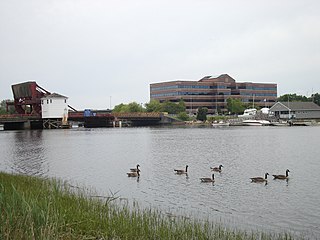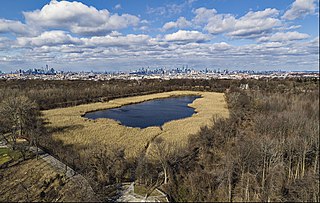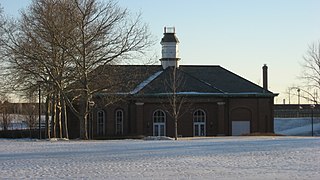
The Neponset River is a river in eastern Massachusetts in the United States. Its headwaters are at the Neponset Reservoir in Foxborough, near Gillette Stadium. From there, the Neponset meanders generally northeast for about 29 miles (47 km) to its mouth at Dorchester Bay between Quincy and the Dorchester section of Boston, near the painted gas tank.

Ridgewood Reservoir is a decommissioned 19th century reservoir and freshwater wetland on the border between the New York City boroughs of Brooklyn and Queens, within what is now Highland Park. Although the reservoir was originally built to secure a reliable water supply for the City of Brooklyn, it is positioned on the Queens side of the border in the neighborhood of Glendale. The reservoir and park are bounded on the north by the Jackie Robinson Parkway, on the south by Highland Boulevard, on the west by Vermont Place and on the east by Cypress Hills National Cemetery.

The Amos Morse House was a historic house at 77 North Street in Foxborough, Massachusetts. It was a two-story wood-frame house, five bays wide, with a hip roof and twin interior chimneys. It was a center entry, Federal Colonial design. It was built circa 1803 by Amos Morse, Sr., for his children, Amos Jr. and Sarah. One of its ells was used by the Morses as a shop for producing straw hats, a significant industry in early 19th-century Foxborough.

The Falmouth Pumping Station is a historic water pumping station on Pumping Station Road in Falmouth, Massachusetts. The complex consists of an 1898 Queen Anne pumping station designed by Ernest N. Boyden, a low-lift pump and water treatment building built in 1993, a chlorination tank also built in 1993, and a house and garage added in 1932. The plant was built in response to rising demand for vacation properties and fire suppression, and continues to fulfill those functions today. The complex was listed on the National Register of Historic Places in 1998.

The Methuen Water Works is a historic water works building on Cross Street in Methuen, Massachusetts. Built in 1893 or soon thereafter, it was one of the city's first major public works project. The surviving building, designed by Ernest N. Boyden, is a distinctive local example of Romanesque architecture. It was listed on the National Register of Historic Places in 1984. It now houses offices of the city's water department.

The Middlesex Fells Reservoirs Historic District is a historic district roughly bounded by Pond St., Woodland Rd., I-93, and MA 28 in Stoneham and Medford, Massachusetts. It encompasses a portion of the Middlesex Fells Reservation, a state park managed by the Massachusetts Department of Conservation and Recreation (DCR). The principal features of the district are three reservoirs and their associated gate houses and pumping stations, which were developed by the Metropolitan District Commission starting in the late 19th century. The district was listed on the National Register of Historic Places in 1990.

The Brooklyn Waterworks, also known as the Milburn Pumping Station, was a historic building in Freeport, Long Island. Designed by noted Brooklyn architect Frank Freeman and completed in 1890, it was described as "Long Island's most ambitious Romanesque Revival design."

Walka Water Works is a heritage-listed 19th-century pumping station at 55 Scobies Lane, Oakhampton Heights, City of Maitland, New South Wales, Australia. Originally built in 1887 to supply water to Newcastle and the lower Hunter Valley, it has since been restored and preserved and is part of Maitland City Council's Walka Recreation and Wildlife Reserve. It was added to the New South Wales State Heritage Register on 2 April 1999.

The Metropolitan District Commission Pumping House is a historic water pumping station, adjacent to Spot Pond in the Middlesex Fells Reservation, on Woodland Road in Stoneham, Massachusetts. Built in 1901 by the Metropolitan District Commission (MDC), it is one of Stoneham's finest examples of Renaissance Revival architecture. The building was listed on the National Register of Historic Places in 1984, and included in the Middlesex Fells Reservoirs Historic District in 1990.

The Fisher Hill Reservoir and Gatehouse are historic elements of the public water supply for the Greater Boston area.

The Albany Pump Station, originally the Quackenbush Pumping Station of the Albany Water Works, is located in Quackenbush Square on Broadway in the city of Albany, New York, United States. It is a large brick building constructed in the 1870s and expanded later in the century.

The Paddington Reservoir is a heritage-listed public park located at 255a Oxford Street in the inner eastern Sydney suburb of Paddington. It was designed by Edward Bell and built from 1864 to 1866 and operated as a water reservoir which accepted water from the Botany Swamps pumping station for supply to parts of Sydney between 1866 and 1899. In the twentieth century the site variously functioned as a service station and storage and mechanical workshop site. In 2006 work commenced to convert the site into a sunken garden and park. It is also known as Walter Read Reserve; Paddington Reservoir Gardens; Reservoir Gardens. The property is owned by City of Sydney. It was added to the New South Wales State Heritage Register on 2 April 1999.

The British Engineerium is an engineering and steam power museum in Hove, East Sussex. It is housed in the Goldstone Pumping Station, a set of High Victorian Gothic buildings started in 1866. The Goldstone Pumping Station supplied water to the local area for more than a century before it was converted to its present use. The site has been closed to the public since 2006, and in March 2018 the entire complex was put up for sale.

The Tashmoo Springs Pumping Station is a historic waterworks facility in Tisbury, Massachusetts, on the island of Martha's Vineyard. The pump station and associated works were first constructed by private interests in the 1880s to provide a reliable water supply for the burgeoning resort areas of Tisbury as well as the port of Vineyard Haven. The facilities were taken over by the town in the early 20th century, after which some alterations were made to accommodate technological improvements. Following a series of hurricanes in the mid-20th century, which highlighted the risks of the station's location and ability to provide reliable drinking water, the town abandoned the facility. Since then it has been largely abandoned, although it was used in the 1990s by a bottled water interest, and some work has been done to preserve the Late Victorian main pumping station building.
The Beaumont St. Louis and San Francisco Railroad Retention Pond is a retention pond originally constructed by the St. Louis, Wichita, and Western Railway Company as a supply pond for the Beaumont St. Louis and San Francisco Railroad Water Tank. It served the St. Louis, Wichita & Western Railway, and supplied the water tank, which was used to refill the boilers of steam locomotives on that line. It was added to the National Register of Historic Places in 2011. From the year of construction until about 1955, when the railroad switched to diesel locomotives, this watering station was essential to railroad transportation.

The Wiregrass Museum of Art is an art museum in Dothan, Alabama. The museum was founded in 1988 and is located in the city's former power and water plant. The building was listed on the Alabama Register of Landmarks and Heritage in 1990 and the National Register of Historic Places in 1991.

West Washington Street Pumping Station is a historic pumping station located in Indianapolis, Indiana. It was built in 1870, and is a one-story, rectangular brick building. It was modified to its present form after 1909, and is 2/3 of its original size. It has a slate hipped roof topped by a square central tower and features distinctive brick detailing, and arched openings. The building served as the city's only water pumping station until 1890.

Goulburn Pumping Station is a heritage-listed former municipal water supply system and now museum at Wollondilly River, Goulburn, Goulburn Mulwaree Council, New South Wales, Australia. It was built from 1885 to 1886. It includes the historic Appleby Steam Engine, which is contained in the pumping station.
The Forsyth Water Pumping Station, on 3rd Ave. at the Yellowstone River in Forsyth, Montana, was built in 1907–1908. It was listed on the National Register of Historic Places in 1990.

Ernest N. Boyden (1852–1918) was an American architect in practice in Boston from 1875 until his death in 1918.





















